Spoločenstvá pterygotného hmyzu (Insecta) v spálenom poraste trstiny obyčajnej (Phragmites spp.) v ornitologickej lokalite trnavských rybníkov (JZ Slovensko)
The Communities of Insects (Insecta, Pterygota) of the Flared Reed (Phragmites spp.) in the Ornithological Locality of Trnava Ponds (SW Slovakia)
Author(s): Radoslav Kvasničák, Katarína Bohunická MinarovičováSubject(s): Geography, Regional studies, Regional Geography
Published by: VERBUM - vydavateľstvo Katolíckej univerzity v Ružomberku
Keywords: Insect; Sticky traps; Wetland of biotop; Reed; Phragmites australis; Burning; Pond; Trnava;
Summary/Abstract: During the vegetation period (april – october) in the year 2015 we observed the quantitative and qualitative representation of the insect community (Insecta) in the flared plain of reed (Phragmites australis) on the Trnava ponds. The ponds are situated near the recreational area Kamenný Mlyn – Trnava (SW Slovakia). The research was to compare the effect of anthropogenic of burning wetland vegetation in two selected habitats, how the site A (affected by fires) and the control site B (not affected by fire). We obtained a total of 1854 ex. insects by the method of sticky traps. insects. They belong to 53 different species originating from 36 different families and 13 ordos. The number of species in the sites was similar (site A 40 species and site B 42 species). The species spectrum consists mainly were the mesophilic insect species with the pratical indicator value. We also record hygrophilic species, which are related to the wetland character of the area: Aeschna cyanea, Sympetrum vulgatum, Chorthippus montanus, Gerris gibbifer, Sialis lutaria, Donacia semicuprea, Chrysomela coerulans, Limnophilus rhombicus, Aedes vexans, and Simulium equinum. The following xerophilic insect species include: Melanogryllus desertus, Macrosteles laevis, Dictyophara europia and Sphex rifocinctus preferring sunny habitat types and warm habitats. We used the standard index of dominance identity (ID = 90.8%), whose determined value indicates ecologically balanced environment and stability of the natural environment in the compared research plots (site A vs. control site B) affected by the burning of wetland vegetation P. australis.
Journal: Disputationes Scientificae Universitatis Catholicae in Ružomberok
- Issue Year: XX/2020
- Issue No: 1
- Page Range: 111-134
- Page Count: 24
- Language: Slovak

